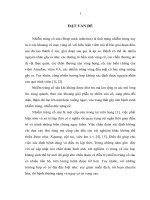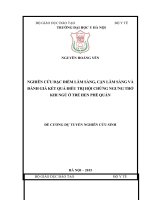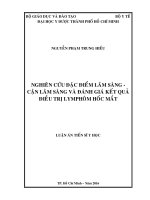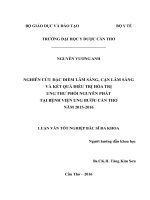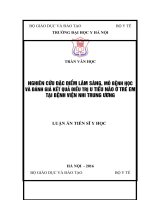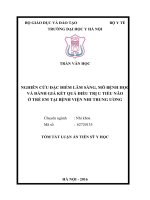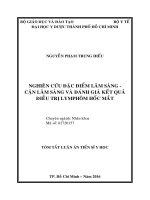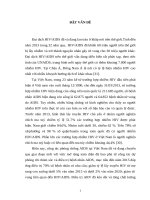Nghiên cứu đặc điểm hình ảnh chụp mạch máu và đánh giá kết quả điều trị dị dạng động tĩnh mạch vùng đầu mặt cổ bằng phương pháp nút mạch tt tiếng anh
Bạn đang xem bản rút gọn của tài liệu. Xem và tải ngay bản đầy đủ của tài liệu tại đây (165.35 KB, 28 trang )
MINISTRY OF EDUCATION
MINISTRY OF HEALTH
HANOI MEDICAL UNIVERSITY
--------------------------
NGUYEN DINH MINH
STUDYING THE ANGIOGRAPHIC FEATURES AND
EVALUATING THE RESULTS OF TREATMENT OF
HEAD&NECK ARTERIOVENOUS MALFORMATIONS
BY ENDOVASCULAR EMBOLISATION
Specialism: Radiology
Code: 62720166
SUMMARY OF PHYLOSOPHY DOCTOR THESIS
HANOI - 2019
Thesis is complete at:
HANOI MEDICAL UNIVERSITY
Thesis supervisor:
NGUYEN DINH TUAN MD, PHD, Assoc Prof
Peer reviewer 1: ......................................................
Peer reviewer 2: .....................................................
Peer reviewer 3: ......................................................
The dissertation will be defended in the University thesis evaluation
council held at Hanoi Medical University
At time........, date 2019
The thesis can be found at:
- National Library
- Central Library of Medical Information
- Library of Hanoi Medical University
- Library of Viet Duc Hospital
LIST OF PUBLISHED RESEARCH
RELATED TO THE THESIS
1. Nguyen Dinh Minh, Nguyen Dinh Tuan and Nguyen Hong Ha
(2018). Imaging characteristics of Head and Neck arteriovemous
malformations, Journal of Practical Medicine; 1084 (11), p. 19-22.
2. Nguyen Dinh Minh and Nguyen Dinh Tuan (2019), Endovascular
embolisation in treatment of Head and Neck arteriovenous
malformations. Vietnam Medical Journal; 480 (1-2), p. 17-20.
1
INTRODUCTION
Head and neck arteriovenous malformations (HNAVMs)) is a
disease that has a severe impact on patient function, aesthetics and
psychology. This disease is rather difficult to treat. A great
challenge in surgical treatment is highly possible to cause excessive
bleeding, demanding to remove completely and the recurrent rate is
still high. Endovascular embolization (EE) standalone or combining
with surgical treatment (ST) are able to cure or alleviate symptoms.
However, in Vietnam so far, there has not been a thorough study of
imaging features as well as treatment capabilities of this method.
Therefore, we study the subject "Studying the angiographic
features and evaluating the results of treatment of head and neck
arteriovenous malformations by endovascular embolization" with
the goal:
- Describe the angiographic features of head and neck
arteriovenous malformations.
- Evaluate the results of endovascular embolization for
treatment of head and neck arteriovenous malformations.
Contribution of the thesis: This is a systematic study of
angiographic imaging (AI) and EE treatment of HNAVMs. The
thesis has the following contributions:
To the HNAVMs angiographic imaging: the study analyzed
the AI of HNAVMs as a basis for detecting and diagnosing the
disease, differentiating with other head and neck vascular lesions,
classifying lesions according to AI to propose appropriate treatment
strategies.
To the HNAVMs treatment: the study highlighted the
important role of EE when combining with ST in treatment of this
disease. In particular, the EE would reduce bleeding in ST, facilitate
complete resection, prevent recurrence after treatment, improve
clinical status and quality of life.
Structure of the dissertation: The thesis consists of 140 pages:
Introduction 2 pages; Chapter 1: Overview 40 pages; Chapter 2:
Objects and research methodology 21 pages; Chapter 3: Results 32
pages; Chapter 4: Discussion 42 pages; Conclusion 2 pages;
Recommendations 1 page. The thesis has 33 tables; 14 charts; 26
photos; 101 references.
2
Chapter 1. OVERVIEW
1.1. HEAD AND NECK ANGIOGRAPHIC ANATOMY
1.1.1. Outline
Head and neck arteriovenous malformations are vascular
abnormalies that occur in the head and neck. This is a rare disease,
likely misdiagnosed with other types of vascular lesions. Treatment
of the disease is so complicated with a high possibility of
recurrence after treatment.
1.1.2. Common carotid artery
Aortic artery branches: brachiocephalic trunk, left common
carotid and subclavian art. From brachiocephalic trunk arises right
common carotid and subclavian art. Vertebral art. comes from
ipsilateral subclavian art.
1.1.3. External carotid artery
External carotid artery (ECA) comes from the common carotid
art., and branches:
1.1.3.1. Superior thyroid artery (STA)
Branching for the thyroid and larynx, connecting with inferior
thyroid art., a branch of thyrocervical trunk of subclavian art.
1.1.3.2. Lingual artery (LA)
Supplying to sublingual and submandibular glands, pharyngeal
mucosa and mandible, oral floor muscles, lingual muscles and
mucosa, connecting with corresponding branches of the facial art.
1.1.3.3. Facial artery (FA)
Branching to submandibular glands, masseter, mandible,
submandibular skin and muscles, cheek, nose and lips, connecting
with transverse facial art. and pharyngeal branches.
1.1.3.4. Accending pharyngeal artery (APA)
Supplying to the mucosa of the ear, nose and throat,
connecting with branches from IMA, FA, mandibular art. The
neuromeningeal branches feeds cranial nerves IX, X, XI and XII.
1.1.3.5. Occipital artery (OA)
Supplying to skin and muscles of neck and posterior area of
head and meningeal branches, branching to the facial nerves.
1.1.3.6. Posterior auricular artery (PAA)
A small branch supplies to the auricular canal.
1.1.3.7. Internal maxillary artery (IMA)
Terminal branches: middle meningeal art. (connecting with
3
ophthalmic art., APA, OA, and vertebral art.). Accessory
meningeal art., inferior alveolar art., and distal branches.
1.1.3.8. Superficial temporal artery (STA)
feeding the scalp, cheeks. This artery is connected with
superior branches of ophthalmic art.
1.1.4. Internal carotid artery
Branches: Ophthalmic art. and terminal branches: anterior
cerebral art., middle cerebral art., posterior cerebral art.
1.1.5. Subclavian artery
Subclavian art. has 5 branches: vertebral art., internal
thoracic art., costocervical trunk, thyrocervical trunk and
suprascapular art.
Vertebral artery includes the spinal and meningeal branches.
The vertebral art. gives a terminal branch as basilar trunk.
1.2. HEAD AND NECK AVMs
1.2.1. Definition
Arteriovenous malformation is a fast-flowing vascular
malformation in which direct communication between the
arteries and veins or capillary system is replaced by a nidus in
which many feeding arteries connect directly to the draining
veins with thickening and fibrosis of vascular walls.
1.2.2. Classification
According to Mulliken and Glowacki (1982), vascular
anomalies includes:
+ Hemangioma
+Vascular anomalies: slow-flow (capillary, venous or
lymphatic malformations), fast-flow (arteriovenous fistulae,
arterial or arteriovenous malformations,) and the syndromes of
vascular malformations.
This classification was supplemented and adopted by the
International Association for the Study of Vascular Abnormalities
(ISSVA), updated in 2014.
Arteriovenous malformations were classified by Hudart E.
(1993) into three categories: arteriovenous fistulae;
arteriolovenous fistulae and arteriolovenulous fistulae. Cho S.K.
(2006) complemented by dividing type III into 2 under groups
4
IIIa and IIIb.
Table 1.1. Cho classification of arteriovenous malformations
Type I:
No more than 3 arteries shunt to a single
(arteriovenous fistulae)
venous component
Type II
Multiple arterioles shunt to a single
(arteriolovenous fistulae)
venous component
Type IIIa:( non-dilated
Multiple fine shunts present between
arteriolovenulous fistulae) arterioles and venules
Type IIIb: (dilated
Multiple dilated shunts present between
arteriolovenulous)
complex arterioles and venules.
1.2.3. Pathophysiology
A defect in the embryonic development of blood vessels.
1.2.4. Pathological anatomy
The arteries are often twist and uneven endothelial fibrosis.
1.2.5. Clinical diagnosis of HNAVMs
Common symptoms are: raised macule, warmer, pulsatile, skin
discoloring, leading to tissue anemia, ulceration, intense pain,
intermittent bleeding and congestive cardiac failure.
Clinical stages (CS) according to Schobinger:
- Stage I (quiescence): a slight pinkish purple color and has
venous circulation, quiet, stable, asymptomatic.
- Stage II (expansion): lesions develop over time, pulsatile and
murmur, presence of tortuous vessels and tight turns.
- Phase III (destructive): symptoms of dystrophy, ulceration,
intense pain, bleeding or affecting organ function.
- Stage IV (decompensation): congestive heart failure.
1.2.6. Diagnostic imaging of HNAVMs
1.2.6.1. X-ray (XR)
- less information, low specificity.
1.2.6.2. Ultrasound (US)
- Hypervascular and rapid-flow lesions, dilated blood vessels,
low arterial resistance index (RI), increased diastolic flow and
arterial spectrum due to the direct shunt between arteries and veins.
1.2.6.3. Computerized tomography (CT)
Dilated, tortuous blood vessels in the lesion with strong
contrast enhancement, early venous enhancement, eroded and
destroyed bones.
1.2.6.4. Magnetic resonance imaging (MRI)
5
Low signal lesions on T1W and higher on T2W, dilated blood
vessels, flow void, hypersignal on TOF and MRA after contrast
injection.
1.2.6.5. Angiography (ANG)
A hypervascular structures, early enhancement, dilated feeding
arteries and draining veins, nidus, arteriovenous shunt, tortuous
vessels, possible aneurysms in feeding arteries or draining veins,
contrast medium stays longer in the nidus.
Classification of Cho based on the AI of HNAVMs commonly
used in the practical treatment of this disease.
1.3. TREATMENT FOR HNAVMs
1.3.1. Conservative treatment
1.3.1.1. Medical treatment
Medicine have a little role in treatment for this disease.
1.3.1.2. Therapeutic treatment
Usually unresponsive to Laser therapy or sclerotherapy.
1.3.2. Endovascular embolization
1.3.2.1. Indications:
. Curative treatment for localized, appropriate lesions.
. Preoperative treatment for reducing bleeding in the ST.
. Palliative treatment when bleeding or unable to ST.
1.3.2.2. Endovascular embolization techniques
a. Transarterial EE (TA): very common but some limitations like
too small, tortuous arteries, dilated draining veins, obstruction of
feeding artery due to previous ligation makes difficult for EE.
b. Direct puncture (DP): complement to TA. Glue injection in
DP is more effective than via micro-catheter for nidal penetration,
shorten procedure time and cost reduction.
c. Transvenous EE (TV): performs when the lesion located in
profound areas, so that difficult to access by direct puncture.
1.3.2.3. Types of material used for embolization:
- Spongel: self-absorbed, only used for temporary occlusion.
- Polyvinyl alcohol (PVA): high possibility of recurrence.
-Microcoils: used combining with glue or absolute alcohol to
occlude dilated feeding arteries and also to occlude draining veins.
- Amplazer plug: used when dilated feeding arteries with rapid
flow but coils are unlikely to success.
- Absolute alcohol: possibility to embolize complex lesions.
However, skin necrosis, ulceration may happen.
6
- N-Butyl Cyanoacrylate (NBCA): common, widely used, less
toxic and safe.
- Ethylene-vinyl Alcohol Copolymer (EVOH): rarely used for
extracranial because of mucosal necrosis, discoloring, high cost.
1.3.2.4. Complications of EE
- Minor complications: no sequelae such as pain, swelling,
headache, hematoma in the groin area, skin necrosis, burns, skin
discoloration, mucosal ulceration, transient paralysis.
- Major complications: death, permanent sequelae, necrosis of
the skin or healthy tissue leaving defected skin must be covered,
brain infarction due to intracranial embolism, irreversible paralysis.
1.3.3. Surgery
For treatment of localized, isolated, accessible, less infiltrative,
small size, single feeding vessel HNAVMs. In addition, surgery
may also be indicated with extensive lesions to alleviate symptoms.
The proposed methods for minimizing the risk of bleeding in
surgery are as ligation of feeding vessels, haemostatic forceps or
preoperative embolization.
Surgery of extensive lesions often leaves large areas of
defected skin. The surgical methods are often used to cover the
defected skin such as rotating flap, skin grafting, peduncle skin,
skin stretching.
1.3.4. Radiosurgery
Rarely used, high-dose irradiation causes gradual thrombosis
and eventually thrombolization. The process takes 1 to 3 years. The
success rate of occlusion depends on the size of the lesion and the
dose of radiation.
1.3.5. The role of EE in combining treatment
EE highly successes in small, uncomplicated, less infiltrative
lesions; however, the rate of recurrence is still high.
EE is also used to supplement ST. Preoperative EE prevents
blood flow to the lesion, thereby reduces bleeding in ST.
Postoperative residual lesions can be continued treatment with EE.
Combination of EE and ST are also used to alleviate symptoms
for large, diffuse lesions, which are unable to total extirpation.
1.3.6. Follow up
By clinical and Doppler, MRI, CT, ANG examinations. The
frequency depends on clinical signs of recurrence, willing to
7
continue treatment when symptoms of recurrence.
1.4. RESEARCHS OF HNAVMs
1.4.1. Researchs of HNAVMs in the world.
Hudart E. (1993) presented an AVMs classification based on the
number and characteristics of A-V shunt in the AI.
For S.K. (2006) supplemented by classifying Type III into 2
subgroups IIIa and IIIb as the basis for selecting treatment methods.
Steinklein J.M. (2018) stated that AI is still the gold standard for
diagnosis and analysis of characteristics of HNAVMs.
In 1829, Benjamin Brodie first treated the scalp AVMs by
suturing around, but the disease early recurred.
Kohout M.P. (1998) combined EE and ST for HNAVM treatment
resulted in 60% cured, of which 69% ST and 62% EE+ST.
Han M.H et al. (1999) used direct puncture for 14 patients with
HNAVMs found that direct puncture can combine with EE.
In 2007, Arat A. et al. treated HNAVMs in 9 patients by Onyx
glue. Resulted in 8/9 cases complete occlusion.
Zheng J.W et al (2009) used absolute alcohol to treat AVMs in ear
for 17 patients. Resulted in 15/17 cases with clinical improvement.
Kim B.(2015) follow-up average 56.6 months: the recurrent rate
was 11.1%, minor complications 25.8% and major 3.8%
1.4.2. Researchs in Vietnam
In 1974, Hoang Xuong and Nguyen Dinh Tuan used EE to treat a
variety of pathologies, including maxilofacial diseases.
In 2007, Do Dinh Thuan highlighted the important role of AI for
the differential diagnosis of hemangiomas and AVM.
In 2017, Do Thi Ngoc Linh stated that the classification of
vascular malformations of Muliken and Glowacki (1982) adopted by
ISSVA in 1996 is simple, easy to apply in clinical practice.
In 2005, Nguyen Dinh Huong performed EE in 34 active
hemangiomas, saw 100% dilated feeding artery, A-V shunt. The rate of
hemostasis was 100%, complete embolism 70.59%. The follow-up
showed 20.59% of good results and 41.18% intermediated.
Le Nguyet Minh (2013) used EE for 30 cases HNAVMs, saw
Cho IIIb was 46.7%, used techniques were 60% TA and DP, 33.3% of
TA. Complete occlusion achieved in 50% of patients. Follow-up
9.7±14 months, 73.3% without recurrence.
In Vietnam, although there have been previous studies on the role
and effectiveness of EE in the treatment of HNAVMs. However, the EE
strategy, patients selection, procedure as well as monitor patients after
8
treatment had not been fully and consistently studied.
Chapter 2. SUBJECTS AND METHODS
2.1. MATERIALS AND METHODS
2.1.1. Criteria for selecting patients
- The patients were diagnosed with HNAVMs, performed ANG
and EE at Viet-Duc friendship Hospital.
- The documents of these patients have sufficient information
for study and stored in Viet-Duc friendship Hospital.
2.1.2. Exclusion criteria
- Non arterial malformations
- Contraindications to endovascular interventions
- Previous treatment with ST or EE.
- Information is not sufficient for study.
- Patient or relatives disagreed with EE treatment.
2.2. LOCATION AND TIME
- Study location: Viet Duc friendship Hospital
- Study period: from January 2012 to December 2018.
2.3. METHODOLOGY
- Follow-up longitudinal descriptive study and non-controlled
clinical trial.
2.4. STUDY DESIGN
2.4.1. Sample size
The sample size for the study is calculated by the formula:
n = minimum sample size for the study.
Z21- α/2 . p . (1-p)
α: = statistically significant level.
n = -------------------Z1-α /2 = expected reliability,
(p.ɛ)2
(taking α = 0.05; Z = 1.96)
p = in the study of Su L. (2015) was 84.8%.
Then, the lowest sample size is 48.
2.4.2. Materials and process of the study
2.4.2.1. Study materials
- Digitalized subtraction angiography (DSA) at Viet Duc
friendship Hospital was used for ANG and fluoroscopy in EE.
- Doppler ultrasound for guiding the needle directly punctured
into the HNAVMs in order to inject glue.
- Multidetector CT-scanner was used for diagnosis and for
follow-up examination.
9
- Devices for ANG include: Introducer, Catheters and
Guidewires for angiography, Microcatheters and microguidewires
for superselective ANG and EE.
- Embolizing materials: NBCA (Hystoacryl), coils, amplazer
plugs, occlusion balloon, PVA, absolute alcohol, Onyx.
- Medications used for procedures: anesthetics, analgesics,
anaphylaxis, contrast media.
2.4.2.2. Preparation
a. Patient preparation
- Clinical examination: physical and local examination, the
history of contrast medium allergy.
- Test results: blood test, coagulation, renal and hepatic
function, electrolytes and immunity.
- Imaging: Ultrasound, CT, MRI, Angiography.
- Contraindications to ANG and EE.
- Explain to patients and relatives to understand the purpose.
b. Prepare medications and monitor patients
- Set an IV line, manage continuously.
- General anesthesia was conducted for children or noncooperating adults.
- Given IV 2500-5000 IU heparin to achieve ACT 2-3 times
c. Device preparation
Introducer,
catheters,
guidewires,
microcatheters,
microguidewires, arterial needle.
d. Prepare embolizing materials
- Glue NBCA, Lipiodol, PVA, microcoils, amplazer plug,
occlusion balloon, absolute alcohol ...
2.4.2.3. Diagnostic angiography technique
a. Arterial catheterization
- Disinfect inguinal area local anesthetic arterial puncture
insert guidewire insert catheter push catheter from femoral
artery up to abdominal aorta and to a desired artery.
b. Selective angiography
- Taking angiography including bilateral external and internal
carotid and ipsilateral vertebral artery.
c. Superselective angiography
Selectively insert microcatheter into a feeding artery and take
an angiography for evaluation.
10
2.4.2.4. Embolisation technique
a. Guidingcatheter insertion technique
Insert a guidingcatheter 5F/6F from inguinal introducer up to
the feeding artery of HNAVMs.
b. Microcatheter insertion technique
Insert a microcatheter through the guiding catheter from the
femoral artery to a feeding artery of HNAVMs. Taking a
superselective angiography to make sure the catheter tip was in
desired position.
c. Transarterial approach technique
The embolizing materials, usually NBCA mixed with Lipiodol
in a concentration of 20% - 50%, were injected via the
microcatheter into the nidus and observed on the screen.
If enlarged feeding arteries with high flow, it is necessary to
use mechanical materials such as amplazer plugs, coils, or balloon
to slowdown the flow before glue injection.
Taking an angiography to confirm that the feeding arteries
were completely blocked and no longer enhancement.
d. Direct puncture technique
After local anesthesia, puncture 20-25G needle into the lesion
under ultrasound guidance. Injecting contrast to determine the
volume, flow, and drainage veins, then, injecting NBCA glue.
e. Transvenous approach technique
Insert the guiding catheter from the femoral vein to the
draining vein and to desired location where embolization is needed.
Deploying coils to reduce venous flow, then, injecting NBCA glue.
2.4.2.5 Follow-up after procedure
Hemodynamic monitoring, pulse and blood pressure, antiedematous analgesic and corticosteroid therapy 3-5 days, detecting
and managing complications.
2.4.2.6. Surgical results analysis
Analyze data like the level of blood loss, the ability to total
extirpation, the methods of covering the defected skin.
2.4.2.7. Long-term follow-up
- Patients participating in follow-up will be:
+ Interviewed self-assessment of disease improvement
+ Clinical examination to assess the degree of improvement
+ Taking CT/MRI/ANG to evaluate the imaging.
11
2.5. STUDY VARIABLES
2.5.1. General characteristics of the patients
- Characteristics of age, gender, time of disease detection,
period of rapid growth, anatomical locations, clinical
characteristics, clinical stages, CT imaging.
2.5.2. Angiographic features of HNAVMs
Lesion size, feeding arteries, draining veins, Cho
classification.
2.5.3. EE treatment of HNAVMs
- Embolizing approach, number of feeding art., embolizing
materials used, NBCA volume, degree of occlusion, complications.
Level of blood loss in ST, surgical methods (complete resection;
partial resection, reconstruction of defected skin). The degree of
clinical improvement, lesion resize, disease control.
2.6. COLLECT DATA
- Study data was collected by data reports.
2.7. ANALYZE DATA
- Managing and analyzing data using SPSS 16.0 software.
- Statistical analysis described the variables of clinical and
imaging features as a percentage and correlations between these
features by pearson χ2 test, with statistical significance when p <0.05.
Comparative analysis of treatment results, finding correlation
between clinical and imaging features by pearson χ 2 test, statistically
significant when p <0.05.
Chaper 3. RESULTS
3.1. GENERAL CHARACTERISTICS OF PATIENTS
3.1.1. HNAVM characteristics by age and gender
-The average age was 29.86±10.97 (12-64 years). The average
age of male was 31.52±10.72 and female 27.57±11.15 (p=0.29).
- 20-40 was the most popular age group, accounting for 70%,
of which 65.5% of male and 76.2% of female at this age, there was
no significant difference between the sexes.
- There were 29 males and 21 females in the study, Male:
Female ratio = 1.38: 1, no significant difference (p=0.26).
3.1.2. Time of detection and period of rapid development
12
3.1.2.1. Characteristics of the time of disease detection
Table 3.1. Characteristics of the time of disease detection (n = 50)
Gender
Male
Female
Total
p
Time
(n)
(%)
(n)
(%)
(n)
(%)
Childhood
13
44,8
10
47,6
23
46
0,98
Puberty
7
24,1
5
23,8
12
24
Maturity
9
31
6
28,6
15
30
Total
29
100
21
100
50
100
- Detected from a childhood was seen in 23 patients,
accounting for 46%, no significant difference between both sexes (p
= 0.98).
3.1.2.2. Characteristics of the period of rapid growth
- There were 25 cases developing correlated with the growth of
patient body, accounting for 50%. The disease grew rapidly in
28.6% women related to pregnancy and 17.2% men to injuries.
3.1.3. Location
3.1.3.1. Characteristics according to anatomical location
- The scalp was the most common area with 17 patients (34%).
Other locations: ears, forehead, cheeks, temples, mandible (14%
-18%). There were 28% lesions expanded more than 1 anatomical
site.
3.1.3.2. HNAVMs related to the midline
- HNAVMs on the left were 42%, higher than on the middle
(36%) and on the right (38%) (p> 0.05). The lesions expanded over
1 region accounted for 16%.
3.1.4. Clinical characteristics
3.1.4.1. Clinical characteristics of HNAVMs
- Raised macule was the most familiar symptom, with 50 cases
(100%). Others were pulsatile 48 (96%), skin discoloring 39 (78%),
bruise 37 (74%), dark red skin 17 (34%).
3.1.4.2. Schobinger clinical stage of HNAVMs
- Stage II was the most common with 36 patients, accounting
for 72%, 81% of women and 65.5% of men were in this stage. Stage
III with 14 patients (28%), men (34,5%) was higher than women
(19%), (p = 0.23). No one was of stages I or IV.
3.1.5. CT imaging features
There were 41 patients diagnosed with CT-scanner.
13
3.1.5.1. CT features of HNAVM structure
- Heterogeneous hyperdensity were seen in 32 patients
(75.6%), undefined margin in 34 (82.9%), soft tissue and skull bone
invasion in 17.1%.
3.1.5.2. CT features of venous size
- The average size of the most dilated vein was 9.2 ± 5.79 mm
(3-23mm). Vein dilated under 10mm were seen more popular with
26 patients (63.4%).
3.2. HNAVM FEATURES ON ANGIOGRAPHY
All 50 patients were diagnosed by angiography.
3.2.1. Angiographic features of HNAVM size
- The average size of HNAVMs was 7.1 ± 3.82 cm (2-22cm).
HNAVMs ≥ 5cm accounted for 72%, larger than 10 cm was 14%.
- Lesions <5cm were only localized in an anatomical area.
Large lesions tended to extent to multiple anatomical sites (p=0.02).
3.2.2. Angiographic features of HNAVM feeding arteries
- The most common feeding artery was the superficial
temporal art., with 56% on the right, 52% on the left, 34% on both
sides.
3.2.3. Angiographic features of the number of feeding artery
Table 3.2. Relation between the number of feeding arteries and size
Size
HNAVM size
<5cm
5-10cm
Total
>10cm
Number of FA
(n)
(%)
(n
)
(%)
(n
)
(%)
(n
)
(%
)
1-5 arteries
13
92,9
24
82,8
2
28,6
39
78
>5 arteries
1
7,1
5
17,2
5
71,4
11
22
Total
14
100
29
100
7
100
50
100
p
<0,01
- The average number of feeding art. was 3.8±2.28 arteries (110 arteries), 22% patients had more than 5 feeding arteries.
- 13/14 lesions <5cm were supplied by 1-5 arteries, accounting
for 92.9%, 5/7 cases >10cm supplied >5 arteries (71.4%). Large
lesions tended to have many feeding arteries (p <0.01).
3.2.4. Angiographic features of HNAVM draining veins
3.2.4.1. Angiographic features of HNAVMs draining veins
- The superficial temporal vein was the most common with
14
32% on the right and 26% on the left. The facial, posterior auricular
and occipital veins accounted for 8% -30%.
3.2.4.2. Angiographic features of the number of draining veins
- Average number of draining veins was 1.86±0.969 (1-5
veins), 66% of cases drained by more than 1 vein.
3.2.5. Cho angiographic classification of HNAVMs
Table 3.3. Cho classification and the time of disease detection
Detected Childhood
Puberty/
Total
p
time
Maturity
Cho’s type
I+II
IIIa+b
Total
(n)
(%)
(n)
(%)
(n)
(%)
1
22
23
4,3
95,7
100
9
18
27
33,3
66,7
100
10
40
50
20
80
100
0,01
- Type IIIa was the most popular, accounting for 42%, Type
IIIb accounted for 38%, Type II was uncommon with 8%. Type I
accounted for 20.7%, only seen in men,
-Type IIIa+b accounted for 95.7% of cases detected from
childhood, but 9/10 patients of type I+II detected at later stage.
- There were 66.7% of type I+II developed after injury, while
94.7% type III rapid grew during puberty/pregnancy and 80%
developed corresponding to the body growth.
3.3. RESULTS OF EE TREATMENT FOR HNAVMs
EE treatment was indicated for all 50 patients with HNAVMs.
3.3.1. Approaching rout to EE in the treatment
- All 50 patients received transarterial EE, accounting for
100%. 32% of cases were combined with direct puncture.
3.3.2. Number of embolized arteries in the treatment
- The average number of embolized arteries was 3.5±2.17
arteries (1-12 arteries). The STA was the highest with 50% on the
right and 52% left.
- The most popular unable embolized art. was ophthalmic
artery, with 18% on the right and 16% on the left. Carotid and
vertebral art. accounted for 2% to 4%.
3.3.3. Direct puncture in the treatment
There were 16 patients transarterial embolization combining
15
with direct puncture (DP), accounting for 32%.
30/39 (76.9%) patients with 1-5 feeding arteries didn’t need
DP, 7/11 (63.6%) cases with >5 arteries were followed by DP. Thus,
more than 5 arteries tended to directly punctured (p= 0.01).
- There were 6/10 (60%) of Cho’s type I+II had DP, but 30/40
(75%) of type III without DP. Cho I+II had a tendency to directly
puncture (p = 0.03).
- DP performed in 8/12 (66.7%) of HNAVMs with dilated vein
≥10mm, but 30/38 (78.9%) with venous size <10mm without DP.
Thus, dilated vein ≥10mm tended to be directly puncture (p<0.01).
3.3.4. Embolized materials used in the treatment
- 100% used NBCA glue. Additional materials were: coils 4%,
amplazer plug 4%, PVA 2% and absolute alcohol 2%.
- Average glue volume was 2.3 ± 2.3 ml (0.5ml-9ml).
- Average volume of glue used in combined transarterial
embolization and DP was 4.1 ± 3.07 ml.
3.3.5. The degree of occlusion after EE treatment
- Occlusion >75% after EE accounted for all patients in which
50% of those were complete embolism.
- 60% of HNAVMs with 1-5 feeding arteries completely
embolized after procedure, while only 9.1% for lesions with >5 art.
Lesions under 5 art. tended to be totally occluded (p<0.01).
3.3.6. Complications after EE treatment
The average time of abnormal symptom presentation after EE
was 4.54 ± 3.21 days, the longest was 13 days.
- The most common was pain and swelling, accounting for
100% and 98%, respectively. Neuropathy, skin ulcers, infections,
hematoma were less common, accounting for <10%.
3.3.7. EE treatment in combination with surgery
- 42 patients were ST, accounting for 84%, and 8 (16%)
without ST. Average time from EE to ST was 5 ± 5.97 days.
- 29 patients were completely resected in ST, accounting for
69.1%, 13 patients were partially excised (30.1%).
- 100% lesions under 5cm were removed totally after ST.
under 5cm lesions tended to be fully resected (p <0.02).
- 82.8% lesions in an anatomical site were fully resected.
Localized lesions tended to be completely resected in ST (p <0.01).
- 100% of Cho’s type I&II were totally excised. Thus, Type
16
I&II of Cho tended to be completely eradicated by ST (p = 0.04).
3.3.8. Bleeding degree in HNAVM surgery
- There were 37 patients with minor bleeding (<100ml) in ST,
accounting for 88% and 5 patients (12%) were major bleeding
(≥100ml), 1 case was transfused 200 ml of blood.
- 94.3% HNAVMs ≤10cm were minor bleeding during surgery,
while 3/7 cases >10cm were major bleeding (p <0.01).
- 30% of cases with >5 feeding arteries presented major
bleeding. Feeding artery >5 tends to bleeding more (p= 0.04).
Table 3.4. Relation of bleeing degree in ST and other factors (n=42)
Bleeding degree
Other features
Schobinger
Stage II
stages
Stage III
Size
0- 10 cm
>10 cm
Feeding
artery
Cho
classification
Direct
puncture
Occlusion
level
1-5 ĐM
>5 ĐM
I+II
IIIa+b
Yes
No
100%
76-99%
Minor
(n)
(%)
(n)
Major
(%)
OR
(95% CI)
27
10
33
4
93,1
76,9
94,3
57,1
2
3
2
3
6,9
23,1
5,7
42,9
4,1
(0,59-27,92)
12,4
(1,56-97,1)
30
7
7
30
11
26
21
16
93,8
70
87,5
88,2
73,3
96,3
95,5
80
2
3
1
4
4
1
1
4
6,2
30
12,5
11,8
26,7
3,7
4,5
20
6,4
(0,9-46,06)
0,9
(0,9-9,7)
0,1
(0,1-1,06)
5,2
(0,53-51,63)
p
0,13
<0,0
1
0,04
0,95
0,03
0,12
- 26,7% lesions with DP had major bleeding in ST, the
proportion was 3.7% for those without DP (p = 0.03).
3.3.9. Follow up results of HNAVM treatment
The average follow-up time was 35.5 ± 26.84 months (2-85)
3.1.4.2. Self-assessment of patients after HNAVMs treatment
- 48/50 patients were interviewed about the degree of
improvement and satisfaction with the treatment. 37.5% of those
responded as total improvement.
- 89.6% of patients said that the disease was better after
treatment, of which 92.5% in the EE + ST group and 75% in the EE
3.1.4.3. Clinical changes after HNAVMs treatment
- 38/50 patients participated in the follow-up examination was
taken CT, of which 32 patients with EE + ST and 6 with EE.
- 21.1% of patients decreased 3 clinical stages according to
Schobinger, 2 stages were 31.6% and 1 stage 28.9%, (p = 0.27).
17
3.1.4.4. HNAVM resize after treatment
- 47.4% of patients were no longer seen enhancement on
follow-up CT images. The lesions with retracted size was 44.7%.
3.1.4.5. The degree of improvement after HNAVM treatment (n=38)
- The "cured" rate is 47.4%, with 1 patient in EE and 53.1% in
EE+ST. The rate of "improved" is 44.7%, 66.7% in EE and 40.6%
in EE+ST. There were 3 patients with "no response", accounting for
7.9%.
Table 3.5. Degree of improvement after HNAVM treatment
Method
Degree
EE
EE+ST
Total
(n)
(%)
(n)
(%)
(n)
(%)
Cured
1
16,7
17
53,1
18
47,4
Improved
4
66,7
13
40,6
17
44,7
No response
1
16,7
2
6,2
3
7,9
p
0,24
- The treatment effectiveness ("cured" and "improved") was
92.1%, of which EE+ST was 93.7% and the EE was 83.4%.
3.1.4.6. Factors related to cure after HNAVM treatment
- While 63.4% of males were cured, only 25% of females
cured after treatment, men were prone to be more cured (p = 0.02).
- 88.9% of patients with Cho’s type I+II were cured, but 34.5%
with Cho’ type III. Cho’s type I+II were higher (p <0.01).
- After DP, 83.3% of patients were cured, while patients
without DP were 30.8%. Thus, DP was higher cured rate (p = 0.02).
- 66.7% of patients with complete embolization were cured,
but 30% in 76-99% occlusion. Completely embolized lesions were
higher chance to be cured (p = 0.02).
Chapter 4. DISCUSSION
4.1. GENERAL CHARACTERISTICS
4.1.1. Age and gender characteristics
Average age of patients was 29.52 ± 10.93 (12-64 years), male
30.93 ± 10.75 and female 27.57 ± 11.15. Previous studies showed
that the average age of HNAVMs ranges from 22 to 39 years old.
We had 29 men and 21 women with Male : Female = 1.38 : 1
(p>0.05). In previous studies, the prevalence of HNAVMs among
18
women and men varied according to studies.
4.1.2. Characteristics of the development of HNAVMs
4.1.2.1. Characteristics of the time of detection
The disease detected from childhood was 46%, during puberty
24%, maturity 30%. Thus, the disease might exist congenitally but
blood vessels had not been dilated, it didn’t show clinical signs.
4.1.2.2. Characteristics of the period of growth
- 33.3% women and 20.7% men rapid grew during puberty and
28.6% women during pregnancy. According to Kohout (1998),
puberty and pregnancy had affected the onset of the disease.
4.1.3. Clinical characteristics of DDTM-AMC according to
Schobinger
4.1.3.1. Clinical characteristics of HNAVMs
According to previous studies, the clinical symptoms of
HNAVMs are characterized by skin macules, redness, warmness,
pulsatile, dry skin, headache, hearing loss. Gradually, the process
leads to ischemia, pain, hypertrophy, bleeding, ulceration and
necrosis, aggravated by heart failure. We saw most of the clinical
signs above but no cases of decompensated heart failure.
4.1.3.2. Clinical characteristics according to Schobinger
According to antecedent studies, the proportion of patients
with clinical stage II was more often, from 34% to 71.1%. Stage IV
was rare because of heart failure and a high risk of complications
during intervention. We met 72% at stage II, 28% at stage III. Thus,
our results were similar to other authors.
4.2. HNAVM FEATURES ON ANGIOGRAPHY
4.2.1. Angiographic features of HNAVMs
Dmytriw A.A. (2014) found that the proportion of mass <3cm
and >3cm were equivalent, no correlation between size and gender.
Kumar R. (2012) couldn’t find a correlation between the size and
the number of feeding arteries. We encountered larger size lesions
with average of 7.1 ± 3.82 cm (2-22cm) and 72% of those ≥5cm.
4.2.2. Angiographic features of HNAVM feeding arteries
4.2.2.1. Angiographic features of feeding arteries
The most common artery was superficial temporal art., with
56% on the right and 52% on the left. This is due to the fact that
34% HNAVMs located in the scarf region, 16% in the ear and 16%
in the forehead, which are supplied from the STA.
19
Kumar R. (2012) results showed that 80.6% of scalp lesions
supplied blood from STA, followed by occipital art. with 70.9% and
branch of contralateral ECA accounted for 26%.
4.2.2.2. Angiographic features of the number of feeding artery
The average number of HNAVM feeding art. was 3.8 ± 2.28
(1-10 arteries). On the other hand, 71.4% lesions with the size
˃10cm were received blood from more than 5 arteries.
According to result of Dmytriw A.A. (2014), 64/89 HNAVMs
were provided blood by multiple arteries and 58/89 lesions were
drained by many veins. But the size of HNAVMs wasn’t related to
the number of feeding arteries.
4.2.3. Angiographic features of HNAVM venous drainage
The average number of draining vein was 1.9 ±0.97, with 66%
patients being drained by >1 veins and 24% by contralateral veins.
The most common vein was the superficial temporal, with 32% on
the right and 26% on the left. The high proportion were the facial,
occipital, posterior ear vein, with 8% to 30%. Multiple drainage
will make it difficult for complete occlusion.
4.2.4. Cho angiographic classification of HNAVMs
In this study, Cho’s type III accounted for 80%. Type I was
12% and only in men. Type II was the lowest with 8%. According to
Cho S.K. (2006), type I is usually a high-flow arteriovenous fistula,
so it is suitable for TA. Type II with venous dilatation can be treated
by TV or DP. Transvenous approach for type III is contraindicated
because venous blockage before arterial occlusion can cause
rupture, bleeding and aggravating the clinical status.
4.3. RESULTS OF EE TREATMENT FOR HNAVMS
4.3.1. Approaching rout in the EE treatment
All 50 patients (100%) were treated by TA in order to
maximize embolisation, 32% of them followed by DP to increase
the occlusion in treatment. TA followed by DP can reduce flow and
allow glue to stay in the nidus, limiting bleeding when puncture and
avoiding washing out glue.
4.3.2. The number of embolized arteries in the treatment
The average number of embolized arteries was 3.5±2.17 (1-12
arteries). The most common artery was STA, with 50% on the right
and 52% on the left, due to blood supplication from this artery
higher than the rest. Follow by IMA, OA with 22% to 28% on each
20
side. Embolizing maxillary or occipital art. were rather safe, only
one case of left IMA with unable embolization.
Feeding from carotid, ophthalmic artery or vertebral art. were
unable to occlude. It is advisable to directly puncture and inject glue
into the nidus for maximizing the level of embolism.
4.3.3. Direct puncture the in the treatment
DP was performed for 32% patients in case the flow still
existed after TA. This was a rather simple, safe and effective
technique in order to increase the possibility of embolism in
HNAVM treatment after TA.
Han M.H. (1999) implemented DP and injected NBCA glue,
resulting 11/14 cases of embolism >90%, 2/3 remaining cases only
achieved embolism 60-70% but significantly reduced bleeding in
ST.
The rate of DP in Type I & II was 60%, higher than that in
Group III (25%), thus, the morphology of Cho I&II was the factor
to increase the likelihood of having DP (p=0.03). However, 66.7%
dilated veins ≥10mm were received to DP, compared to 21.1% of
˂10mm (p<0.01). Moreover, the results showed that 23.1% cases
having 1-5 feeding art. were performed DP, compared to 63.6%
cases >5 art. (p=0.02). Thus, lesions with dilated vein >10mm or >5
feeding arteries increased the likelihood of DP.
4.3.4. Embolized materials used in the treatment
NBCA glue was used for all patients in this study. The average
volume of glue was 2.3 ± 2.3 ml (95% CI: 1.68 - 2.96).
On the other hand, the amount of glue raised as the lesions
increasing in size, with 1±0.48 ml for sizes <5cm, 2±1.7 ml for 510cm and 6±3.2 ml for >10cm (p<0.01). In addition, the volume of
glue used in TA+DP was 4.1±3.07 ml, which was higher than TA
alone 1.3±0.74 ml (p<0.01). Correlation between size and amount
of glue helped to estimate the glue volume during the procedure.
PVA was used to occlude a small branch of the IMA so that the
plastic article could drift far into the nidus without causing a
proximal blockage.
Absolute alcohol was used for 1 patient in combination with
NBCA glue. Although absolute alcohol has potential advantages in
HNAVM treatment, the risk of complications is still high. The
embolized effect of absolute alcohol is slow and long-term so it is
21
very limited using pre-operation.
4.3.5. The degree of embolisation after EE treatment
The level of embolization achieved >75% for all patients, of
which 50% was completely occluded. The results showed that the
more feeding art., the more difficult to complete occluded (p<0.01).
According to Bhandari P.S. (2008), the embolized percentage
was 70%-100% with materials like PVA, Gelatin and NBCA glue.
The results of Han M.H. (1999) were 6 patients with 100% vascular
occlusion and 5 patients with >90%. Although there were 3 cases
only reached 60-70% occlusion but very little bleeding in ST.
Thus, the result of the embolized degree achieved in this study
is similar to previously published.
4.3.6. Complications after EE treatment
The common symptoms after EE were pain (100%) and
swelling (98%), lasting from days to several weeks until surgery.
Epidermal ulceration was less common (6%), usually due to the
embolism of superficial or bilateral arteries. Nervous injury (10%)
such as eyelash collapse (2 patients), complete recovery of facial
paralysis (1 patient), decreased sense of forehead skin (2 patients),
insignificantly affecting patient lives.
Kim B. (2015) encountered 25.8% of minor and 3.8% of major
complications. Dmytriw A.A. (2014) saw a patient who was stroke
due to glue drifting to the carotid system while microcatheter
withdraw causing a middle cerebral infarct.
3.3.7. EE treatment in combination with surgery
In this study, 42/50 patients were performed ST after EE,
accounting for 84%. The average time from EE to ST was 5 ± 5.97
days (1-38 days). However, 50% patients received ST ≤3 days.
According to previous studies, the average time of 24-72 hours
is the most ideal to avoid blood recirculation for the lesions. Early
surgery would prevent revascularization, reduce bleeding during
surgery, make the most effective embolism, alleviate long-term pain
after EE and avoid the risk of local tissue infection.
After ST, 69% of cases were completely resected, the
remaining 31% were partially removed. The study showed that the
possibility of total resection was related to factors such as limited
size <5cm (100%) (p <0.02), localization in one anatomical site
(82.1%) (p <0, 01) and Cho type I&II (100%) (p=0.04).
22
3.3.8. The degree of blood loss in surgical treatment
According to the study, bleeding under 100ml in ST accounted
for 88.1% cases, but there were still 11.9% cases bleeding > 100ml.
Major bleeding was related to large size >10cm, multiple feeding
arteries >5, performing DP, incomplete embolization (p<0.05). This
is because large lesions were often involved in many vascular and
nervous structures leading to prolong ST time. On the other hand,
HNAVMs are usually supplied by numerous arteries so it is difficult
to completely occlusion all arteries, that why DP should be
followed. Other while, these lesions will be quickly perfused from
the remaining arteries through a rich circulation of head and neck,
causing a high risk of bleeding during ST.
According to Kumar R. (2012), the amount of blood loss
during HNAVM surgery was 50ml to 484 ml. Karim A.B. (2016)
injected NBCA glue or Surgiflo to treat 12 patients with HNAVMs,
blood loss in ST was from 15 - 100ml.
Thus, the preoperative EE significantly reduced bleeding
during HNAVM surgery and created a dry surgical field that helped
surgeons to maximize resection.
3.3.9. Results of follow up after HNAVM treatment
3.3.9.1. Self-assessment of patients after HNAVMs treatment
Of 48/50 patients interviewed after treatment, 89.6% said the
disease was better improvement, of which 92.5% in EE+ST and
75% in EE group. Only 8.3% said that the disease did not change
and one patient supposed the disease tends to get worse.
Results of Wu J.K (2005) showed that 86.4% of patients
improved after treatment, but 14.3% did not improve. According to
Le Fourn E. (2015), 72.2% of cases improved their symptoms,
11.1% did not change and 16.7% worsened.
Thus, our research results were similar to other authors.
3.3.9.2. Clinical changes after HNAVMs treatment
38/50 patients in follow-up examination, accounting for 76%.
The average follow-up time was 35.5 ± 26.84 months (2-85
months). Clinical stage reduction was in 81.6% of patients, in which
the reduction of 3 stages was 21.1%, 2 stages was 31.6% and 1
stage was 28.9%. There was no difference between EE+ST and EE
group (p=0.27). Thus, the degree of clinical improvement after
treatment was less affected by the disease severity.

